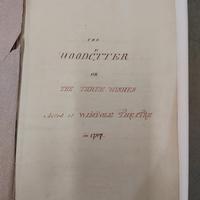The Woodcutter, or The Three Wishes
‘Mithraic Groves and Gothic Towers: Reuniting the Lost Literary Legacies of Wrest and Wimpole’ is a one-year Knowledge Exchange between the University of Oxford, English Heritage, and the National Trust. The project aims to uncover the vibrant intellectual culture that characterised Wrest Park and Wimpole Hall in the eighteenth-century when both properties were owned by the literary Yorke family.
History
The Woodcutter, or, The Three Wishes is an exciting example of the shared literary culture between Wimpole Hall and Wrest Park. Loosely inspired by Shakespeare’s Midsummer Night’s Dream and a French play, Le Bucheron [The Woodcutter],[1] it was first written in 1797 by Elizabeth Countess of Hardwicke as a play to amuse the children over the Christmas holidays. It tells the story of Hodge, an obstinate, lazy woodcutter, who is unexpectedly granted three wishes by Oberon, King of the Fairies. Although Hodge entertains fanciful notions of living a glamorous life – even making himself a king – he manages to blow one of his wishes on eel (it is at least an ‘excellent eel, and well roasted too’[2]) and hilarious chaos ensues.
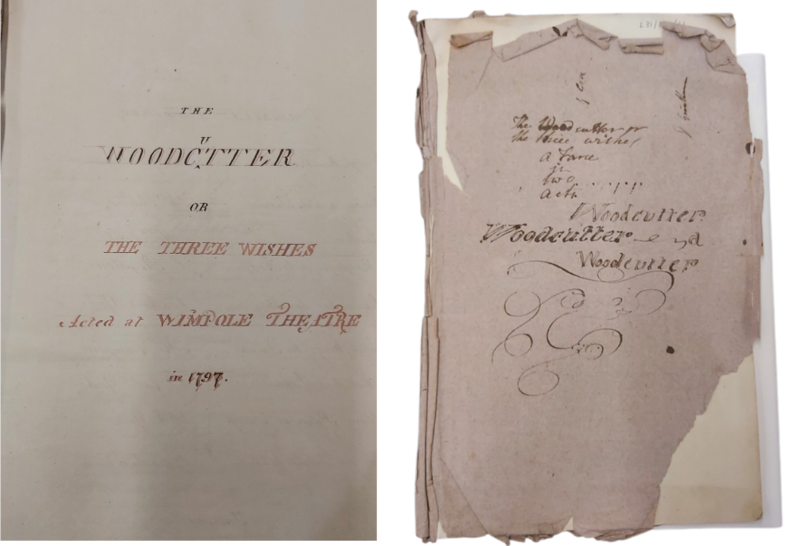
The original manuscript of The Woodcutter. BLARS L31/340/62
The cast list from the original surviving manuscript of The Woodcutter shows that it was very much a family production: Elizabeth’s own children Philip (aged 12), Anne (aged 13), Catherine (aged 10), Elizabeth (aged 7), and Caroline (aged 2) were all cast in the play, as well as their cousins, Thomas Robinson (aged 15) and Frederick Robinson (aged 14). It also reveals that there was some comedic cross-dressing too, with Philip playing Margery, wife of Hodge, and the children’s aunt, Caroline Eliot, playing the Justice.
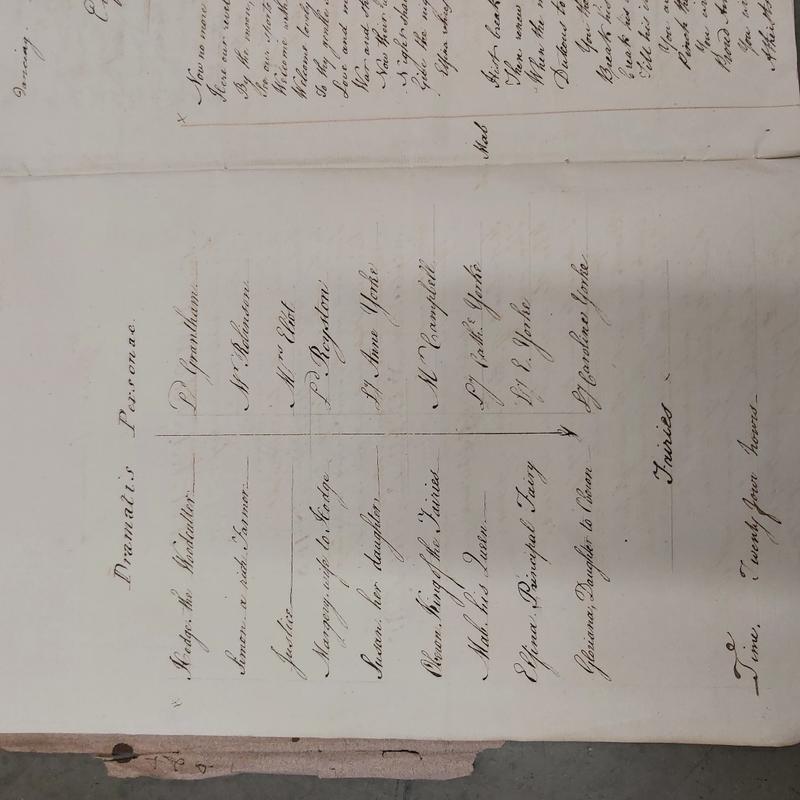
The original cast list from The Woodcutter. BLARS L31/340/62
Plays over the Christmas period were a family tradition and seem to have been the highlight of the children’s holidays. Thomas Robinson recalled the excitement as he and his cousins prepared for the performance, ‘to which we attached much importance’, as they learned their lines and painted scenery.[3] Unfortunately, after all their efforts, the performance had to be cancelled as Thomas’s grandmother, Jemima Marchioness Grey, died early in the new year. Later sources do suggest that the play was performed in the Gallery at Wimpole another time.[4]
Thomas Robinson was so inspired by these early family theatricals, that when he eventually came into his inheritance at Wrest Park, he had a theatre built for similar performances in the dining room – even installing a special moveable wall to expand the space. Coming full circle, he staged The Woodcutter again for his own grandchildren in 1849, recalling in his memoirs that in order to ‘amuse the children’, they had performed a piece ‘which had been written many years ago by the Dowager Lady Hardwicke and had been acted at Wimpole.’
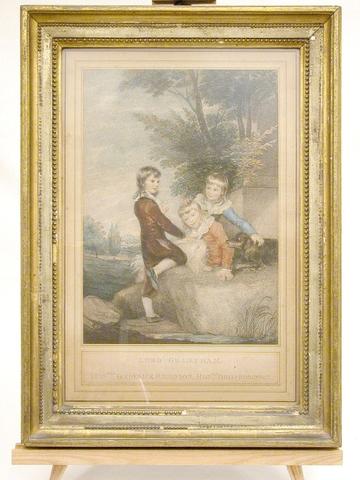
Lord Grantham and his brothers Frederick and Philip Robinson as boys against a landscape background, after Sir Joshua Reynolds. Saltram © National Trust / Sophia Farley & Denis Madge.
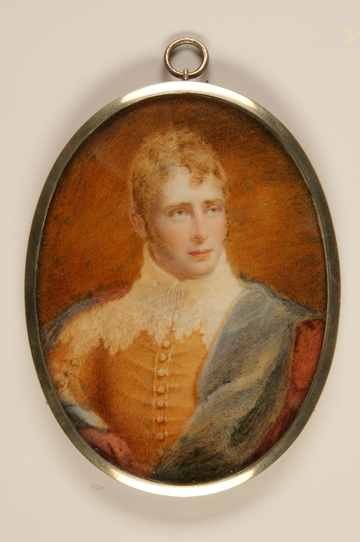
Thomas Philip Robinson, Lord Grantham, later 2nd Earl de Grey of Wrest, KG, PC, FRS (1781 - 1859) attributed to Emma Leonora Kendrick. © National Trust / Bryan Rutledge [5]
A charitable cause
The Woodcutter did become known outside the private family theatricals too. At the request of Queen Adelaide, Elizabeth revised and published the play as The Court of Oberon in 1831. It was dedicated to Princess Victoria, the future Queen, and sold at a bazaar intended to raise money ‘for the succour of the distressed Irish.’[6]
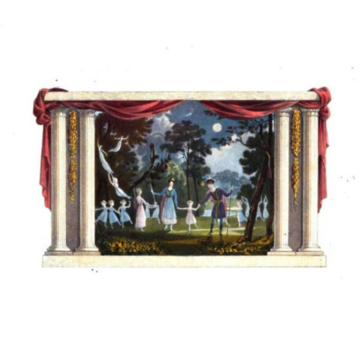
An illustration from The Court of Oberon (1831)
Yet Elizabeth was not seeking to establish a name for herself as a professional writer. Conservative in her outlook, she viewed her playwriting as an extension of her role as a mother. Even when the play was published, stressing the charitable cause in the preface further justified her actions as socially acceptable within the bounds of feminine propriety. The Woodcutter itself reinforces social hierarchies rather than challenges them: despite Hodge’s dreams of social advancement, he merely wastes his wishes, and the overall message is that the poor should be content with what they have.[7]
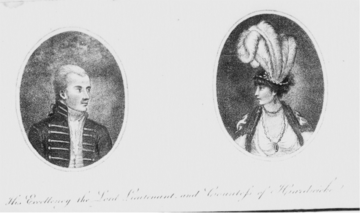
‘His Excellency the Lord Lieutenant and Countess Hardwicke’, Walker’s Hibernian Magazine, or Compendium of Entertaining Knowledge, Dec 1801. ProQuest. P. 705.
Revived theatricals at Wimpole Hall
At the age of 90, Elizabeth was still alive to see The Court of Oberon performed again by the new generation at the ‘Wimpole Theatre’ in the gallery in 1851 and 1853.
Family theatricals continued to crown the Christmas holidays; in her memoirs of her father, the fourth Earl of Hardwicke, Elizabeth Biddulph recalls the fun they had reviving the plays at Wimpole:
“We rehearsed and acted in the Gallery, originally built to hold the Harleian Manuscripts, and divided by columns into three parts, making an admirable theatre and a handsome proscenium. On one great occasion we had Frank Matthews as prompter, and we none of us forget seeing him initiate Lady Agneta in the art of making a stage kiss. Oh! how we laughed. He cried so much during the performance that he prompted badly; but perhaps the dear man was touched by the family talent!”[8]
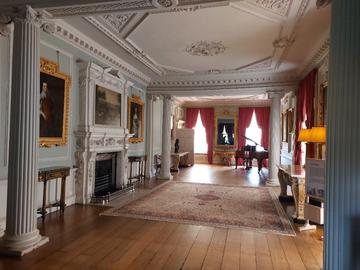
The Gallery at Wimpole Hall, Cambridgeshire.
Staging the play in 2023
As part of the Knowledge Exchange Fellowship, students from Lady Margaret Hall have brought The Woodcutter to life once more in the same playful spirit, with plenty of comic cross-dressing and even a mascot eel.
Student directors, Sylvie Knight and Eleanor Housden, comment on the experience, that:
“Rehearsals for the performance so far have been such a lovely opportunity for us to come together outside of academic study. LMH is such a strong community and we really hope that the close bonds we have with one another are reflected in the play and convey something akin to the familial connection that original performances would have had. We are all delighted to have the opportunity to perform in the country houses of Wrest and Wimpole and are looking forward to June!”
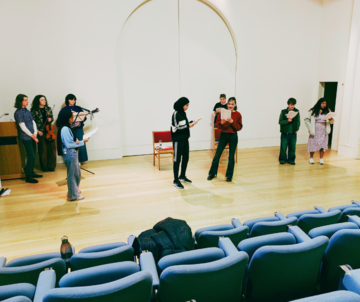
Student rehearsal at Lady Margaret Hall, February 2023.
The opening performance will be held at the Simpkins Lee Theatre, Lady Margaret Hall on 10th June at 7pm. From there, the students will take the play on tour to both family homes where the play was once performed by the family, performing at Wimpole on the 12th and 13th June and Wrest Park on the 14th. It is an incredible opportunity to see this play performed again in the original historical settings and promises to be a highly entertaining performance.
With special thanks to Dr Natasha Simonova for acting as an academic consultant on the project.
Further links
Book via Eventbrite for the LMH performance: https://www.eventbrite.co.uk/e/the-woodcutter-performance-at-lmh-tickets-567617568427
No booking required for the Wimpole Hall and Wrest Park performances.
[1] Lady Mary Grantham, cousin of the third Earl of Harwicke, wrote that ‘Ldy H… is composing rather than translating Le Bucheron’. Plymouth and West Devon Record Office, 1259/2/313
[2] Elizabeth Yorke, Countess of Hardwicke, The Woodcutter, BLARS, L31/340/61.
[3] Thomas Robinson, ‘Memoirs of my own Life’, BLARS, CRT190/45/2, p. 5.
[4] Elizabeth Yorke, Countess of Hardwicke, ‘Preface’, The Court of Oberon (London: W. Nicol, 1831).
[5] Thomas Robinson, ‘Memoirs of my own Life’, BLARS, CRT190/45/2, p. 61.
[6] Elizabeth Yorke, Countess of Hardwicke, ‘Preface’, The Court of Oberon (London: W. Nicol, 1831).
[7] For more about Elizabeth Yorke’s ideology, see Judith Hawley, ‘Elizabeth and Keppel Craven and the Domestic Drama of Mother-Son Relations’, Stage Mothers: Women, Work, and the Theater, 1660-1830, ed. by Laura Engel, pp. 164-176 (p. 166).
[8] Elizabeth Philippa Bidulph, Charles Philip Yorke, Fourth Earl of Hardwicke, A Memoir (London: Smith Elder, 1910)
